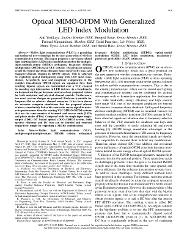| dc.contributor.author | Yeşilkaya, Anıl | |
| dc.contributor.author | Basar, Ertugrul | |
| dc.contributor.author | Miramirkhani, Farshad | |
| dc.contributor.author | Panayırcı, Erdal | |
| dc.contributor.author | Uysal, Murat | |
| dc.contributor.author | Haas, Harald | |
| dc.date.accessioned | 2019-06-27T08:01:17Z | |
| dc.date.available | 2019-06-27T08:01:17Z | |
| dc.date.issued | 2017 | |
| dc.identifier.issn | 0090-6778 | en_US |
| dc.identifier.issn | 1558-0857 | en_US |
| dc.identifier.uri | https://hdl.handle.net/20.500.12469/329 | |
| dc.identifier.uri | https://doi.org/10.1109/TCOMM.2017.2699964 | |
| dc.description.abstract | Visible light communications (VLC) is a promising and uncharted new technology for the next generation of wireless communication systems. This paper proposes a novel generalized light emitting diode (LED) index modulation method for multiple-input-multiple-output (MIMO) orthogonal frequency division multiplexing (OFDM)-based VLC systems. The proposed scheme avoids the typical spectrum efficiency losses incurred by time- and frequency-domain shaping in OFDM signals. This is achieved by exploiting spatial multiplexing along with LED index modulation. Accordingly real and imaginary components of the complex time-domain OFDM signals are separated first then resulting bipolar signals are transmitted over a VLC channel by encoding sign information in LED indexes. As a benchmark we demonstrate the performance analysis of our proposed system for both analytical and physical channel models. Furthermore two novel receiver designs are proposed. Each one is suitable for frequency-flat or selective channel scenarios. It has been shown via extensive computer simulations that the proposed scheme achieves considerably better bit error ratio versus signal-to-noise-ratio performance than the existing VLC-MIMO-OFDM systems that use the same number of transmit and receive units [LEDs and photo diodes (PDs)]. Compared with the single-input single-output (SISO) DC biased optical (DCO)-OFDM system both spectral efficiency and DC bias can be doubled and removed respectively simply by exploiting a MIMO configuration. | en_US] |
| dc.language.iso | eng | en_US |
| dc.publisher | IEEE-INST Electrical Electronics Engineers Inc | en_US |
| dc.rights | info:eu-repo/semantics/openAccess | en_US |
| dc.subject | Visible light communications (VLC) | en_US |
| dc.subject | Multiple-input-multiple-output (MIMO) systems | en_US |
| dc.subject | Orthogonal | en_US |
| dc.title | Optical MIMO-OFDM With Generalized LED Index Modulation | en_US |
| dc.type | article | en_US |
| dc.identifier.startpage | 3429 | en_US |
| dc.identifier.endpage | 3441 | |
| dc.relation.journal | IEEE Transactions on Communications | en_US |
| dc.identifier.issue | 8 | |
| dc.identifier.volume | 65 | en_US |
| dc.department | Fakülteler, Mühendislik ve Doğa Bilimleri Fakültesi, Elektrik-Elektronik Mühendisliği Bölümü | en_US |
| dc.identifier.wos | WOS:000411006100018 | en_US |
| dc.identifier.doi | 10.1109/TCOMM.2017.2699964 | en_US |
| dc.identifier.scopus | 2-s2.0-85029509430 | en_US |
| dc.institutionauthor | Yeşilkaya, Anıl | en_US |
| dc.institutionauthor | Panayirci, Erdal | en_US |
| dc.relation.publicationcategory | Makale - Uluslararası Hakemli Dergi - Kurum Öğretim Elemanı | en_US |
















